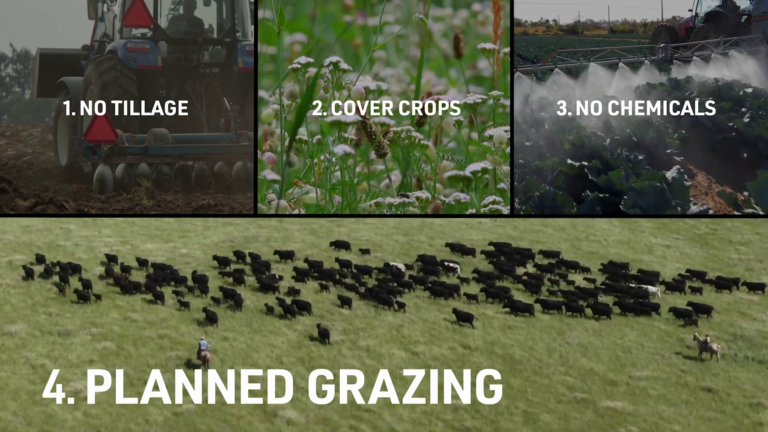Regenerative Agriculture: 4 steps to better food
Have you recently bought food from the grocery store and felt that there was something off about it? Maybe the spinach seemed empty of nutrients. Or the tomatoes were flavorless. Perhaps you remember that the vegetables of your youth just seemed healthier and better tasting. You are not alone. A study conducted by the Institute for Functional Medicine found significant differences in nutrient content between organically and conventionally grown crops. The study highlighted that organic crops have higher concentrations of antioxidants such as polyphenols. For example, phenolic acids were found to be 19% higher, flavanones 69% higher, and anthocyanins 51% higher in organic crops compared to their conventional counterparts. This suggests that the method of crop production, including practices used in factory farming, can impact the nutrient density of fruits and vegetables.
So how can we fix this problem and make our food healthier? Regenerative agriculture practices represent a paradigm shift in our approach to farming. Regenerative organic farming requires a commitment to practices that restore the earth and foster sustainable ecosystems. This comprehensive guide explores the essence of regenerative agriculture, focusing on its fundamental elements: no-tillage, cover crops, avoiding chemicals, and planned grazing.
What is Regenerative Agriculture?
Regenerative agriculture is a holistic approach to farming that focuses on improving soil health, increasing biodiversity, and restoring the ecosystem. This method goes beyond sustainable agriculture; it actively works to reverse the damage caused by conventional farming practices. By prioritizing soil health and ecosystem balance, regenerative agriculture aims to produce nutritious food while also combating climate change and preserving the planet for future generations.
The Role of No Tillage in Regenerative Agriculture
No tillage, a cornerstone of regenerative agriculture, involves leaving the soil undisturbed. This practice preserves the soil structure, prevents erosion, and maintains the organic matter within the soil. By not tilling, farmers allow the natural ecosystem to thrive, encouraging a diverse range of organisms that contribute to soil fertility and health. No tillage also plays a significant role in carbon sequestration, helping to reduce greenhouse gas emissions.
Cover Crops: Nature’s Blanket for Soil
There is a key moment in the film Common Ground where farmer Rick Clark of Farm Green talk about how in 2006, after tilling his land to plant corn, there was a one-inch rain event. As he drove to check on the field, he noticed that the soil was getting washed away, creating significant erosion to his land. This was the moment he realized that cover crops were going to be necessary if he wanted to keep his fields from eroding any further. At the time, this was something that wasn’t practiced by non-regenerative farm systems. Cover crops, such as legumes and grasses, are planted to cover the soil rather than for harvest. These crops play a crucial role in regenerative agriculture by improving soil fertility, reducing erosion, and enhancing water retention. Cover crops act as a natural fertilizer, adding organic matter back into the soil and supporting a healthy microbial ecosystem. Management practices in regenerative organic farming such as crop rotation help suppress weeds and reduce the need for chemical pesticides.
Chemical-Free Farming: Back to the Roots
In 1974 Monsanto introduced the herbicide Roundup. It quickly became popular due to its effectiveness and eventually became one of the most widely used agricultural chemicals in the world. Unfortunately, not only does it kill unwanted pests, but it kills a great many other organisms that contribute to soil health. It also has been linked to various forms of cancer in humans as well. Chemical-free farming is integral to regenerative agriculture. By avoiding synthetic fertilizers and pesticides, regenerative farmers allow natural processes to maintain soil health and plant growth. This approach fosters a balanced ecosystem where beneficial insects and microorganisms can thrive, reducing the need for external inputs. Chemical-free farming not only benefits the environment but also produces healthier, more nutrient-rich crops. This allows the land to regenerate each season. Regenerative organic agriculture results in a healthier ecosystem and healthier people.
Planned Grazing: Balancing the Ecosystem
The definition of regenerative agriculture also includes planned grazing land management practice. Planned grazing involves managing livestock movement to mimic natural grazing patterns. This practice helps maintain grassland health, improves soil fertility, and increases carbon sequestration. In regenerative organic farming, planned grazing ensures livestock contributes positively to the ecosystem, promoting soil regeneration and biodiversity.
Regenerative Agriculture and Climate Change
Regenerative agriculture practices are a potent tool in the fight to reverse climate change. By enhancing soil organic matter and promoting carbon sequestration, these practices significantly reduce greenhouse gas emissions. Healthy soils can store more carbon dioxide, mitigating the impacts of climate change and helping to stabilize our climate.
Biodiversity: A Cornerstone of Regenerative Agriculture
Biodiversity is essential in regenerative farming. A diverse range of plants and animals contributes to a resilient agricultural ecosystem, promoting natural pest control and enhancing soil health. By fostering a variety of life forms, from microorganisms to larger animals, regenerative agriculture creates a self-sustaining environment that reduces the need for external inputs and interventions.
The Economic Benefits of Regenerative Agriculture
Regenerative agriculture is not only environmentally sustainable but also economically viable. By reducing reliance on expensive chemical inputs and improving soil health, farmers can reduce costs and increase the long-term productivity of their land. Furthermore, regenerative practices can lead to higher quality and potentially higher-priced agricultural products, offering farmers an opportunity to tap into the growing market for environmentally friendly and healthy food.
Transitioning to Regenerative Agriculture
Transitioning from conventional agriculture to regenerative agriculture can be particularly challenging, especially for farmers accustomed to traditional practices. It requires a shift in mindset, a deep understanding of ecological processes, and often, a significant initial investment. However, with the right strategies like the principles of regenerative agriculture, community support, and policy incentives, a transition from conventional agriculture can lead to a more sustainable and profitable farming future.
Several initiatives are currently underway to transition factory farms to regenerative agriculture principles. For more please visit https://100millionacres.org/.
The Global Impact of Regenerative Agriculture
The regenerative agriculture movement has the potential to make a profound impact on a global scale. By improving soil health through regenerative organic practices, food production can be increased, especially in regions vulnerable to extreme weather due to climate change. Success stories from around the world demonstrate how regenerative practices can revitalize landscapes, support communities, and contribute to a more sustainable global food system.
Joining the Regenerative Movement
Everyone can play a role in supporting regenerative agriculture. Consumers can choose products from regenerative farms, while communities can support local regenerative agriculture initiatives. There’s a growing global network of farmers, scientists, and advocates working together to advance this movement, and by joining in, we can all contribute to a healthier planet.
Regenerative agriculture offers a hopeful path forward in our journey towards a more sustainable and resilient food system. By embracing practices like no tillage, cover crops, chemical-free farming, and planned grazing, we can revitalize our soil, enhance biodiversity, and fight climate change. This transition requires commitment, knowledge, and community support, but the rewards—a healthier planet and a sustainable future—are immeasurable.
Key Takeaways:
- Regenerative agriculture is an approach that heals the land and promotes ecological balance.
- Core practices include no tillage, cover crops, avoiding chemicals, and planned grazing.
- The principles of regenerative agriculture such as crop rotation, enhance soil health, increase biodiversity, and help reverse climate change.
- Transitioning to regenerative agriculture is a journey towards economic sustainability and environmental resilience.
- Everyone can contribute to this movement, creating a more sustainable future for our planet.

